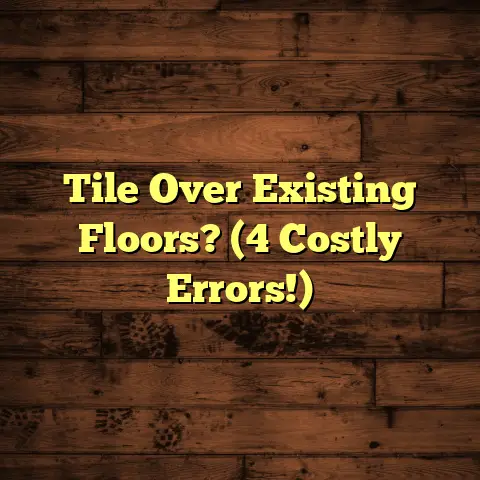Vinyl Over Ceramic Tile? (2 Things To Check!)
I’ve seen it all, from shag carpets that devoured socks to the sleekest, most modern installations. But there’s one question that pops up time and time again: “Can I put vinyl over ceramic tile?”
Let’s face it, we all get that itch to refresh our homes. Remember those family gatherings in the kitchen, everyone crammed around the table, laughing and sharing stories?
Floors are the silent witnesses to these moments, and sometimes, they need a little love. Maybe that ceramic tile is looking a bit dated, or perhaps you’re just craving a change.
That’s where vinyl comes in – affordable, durable, and oh-so-stylish. But before you grab that measuring tape and start dreaming of new floors, there are a couple of crucial things you need to check.
1. The Rise of Vinyl Flooring
1.1. A Blast From the Past
Vinyl flooring has been around longer than you might think. It really took off in the mid-20th century as a budget-friendly alternative to hardwood and linoleum.
Think back to those kitchens of the 1950s and 60s – vinyl was everywhere.
1.2. Vinyl Today: Options Galore
Fast forward to today, and vinyl has had a serious glow-up. We’re not just talking about those old-school, thin sheets anymore.
Luxury vinyl tiles (LVT) and planks (LVP) are the rockstars of the flooring world. They mimic the look of wood, stone, and even ceramic with incredible realism.
And sheet vinyl? It’s still around, but it’s been revamped with improved designs and durability.
1.3. Why Vinyl is King (or Queen!)
So, what makes vinyl so popular? Well, for starters, it’s tough. I’ve seen vinyl floors withstand everything from kids and pets to clumsy adults (myself included!).
It’s also super easy to clean – a quick sweep and mop, and you’re good to go. Plus, it’s water-resistant, making it perfect for kitchens, bathrooms, and even basements.
And let’s not forget the price. Vinyl is generally more affordable than hardwood, tile, or stone, making it a great option for budget-conscious homeowners.
2. Understanding Ceramic Tiles
2.1. The Timeless Classic
Ceramic tile has been a staple in homes for, well, centuries. It’s known for its durability and classic appeal.
Think of ancient Roman bathhouses – those floors were often made of ceramic tile!
2.2. The Power of Ceramic
What makes ceramic so special? It’s incredibly resistant to heat, moisture, and stains.
That’s why you see it so often in kitchens and bathrooms – it can handle spills, splashes, and even the occasional dropped lasagna.
2.3. A Feast for the Eyes
Ceramic tile isn’t just practical; it’s also beautiful. It comes in a dizzying array of colors, patterns, and finishes.
You can find everything from simple, classic white tiles to intricate, hand-painted designs.
Ceramic can really elevate the look of any space.
3. Vinyl Over Ceramic: A Match Made in Heaven?
3.1. The Quick Refresh
Okay, so you’ve got ceramic tile, and you’re eyeing that gorgeous vinyl flooring. Can you put one over the other?
The answer is: sometimes.
Installing vinyl over existing ceramic tile is a popular way to update a room without the hassle and expense of ripping out the old tile.
3.2. Why Go This Route?
There are several reasons why homeowners choose this approach.
First, it’s cost-effective. Tearing out ceramic tile can be expensive, not to mention messy. Installing vinyl on top saves you money on demolition and disposal costs.
Second, it saves time. Ripping out tile is a labor-intensive process.
Putting vinyl on top is much faster, meaning you can enjoy your new floors sooner.
Finally, it minimizes disruption. Demolition can create a lot of dust and noise.
Installing vinyl over tile is a much cleaner and quieter process.
4. Two Key Things to Check Before Installation
Alright, so you’re thinking about going for it. Before you even think about adhesives or underlayment, you absolutely need to check these two things:
4.1. Subfloor Stability and Condition
The Foundation is Key
Imagine building a house on a shaky foundation. It’s not going to end well, right?
The same principle applies to flooring. The ceramic tile acts as the subfloor for your vinyl, so it needs to be in good shape.
Hunting for Trouble
Here’s what to look for:
-
Loose Tiles: Gently tap each tile with a rubber mallet or even the handle of a screwdriver. If you hear a hollow sound, that tile is likely loose.
-
Cracks: Inspect the tiles for any cracks, no matter how small. Even hairline cracks can cause problems down the road.
-
Uneven Surfaces: Run your hand over the tile surface. Do you feel any dips, bumps, or unevenness? These imperfections will telegraph through the vinyl, creating an unsightly and potentially uncomfortable surface.
Tools of the Trade
Here are a few tools that will help you assess the subfloor:
-
Rubber Mallet: For tapping tiles and listening for hollow sounds.
-
Straightedge: To check for unevenness. A 6-foot level works well.
-
Moisture Meter: Crucial for detecting moisture issues (more on that in the next section).
-
Visual Inspection: Your eyes are your best tool! Look closely for any signs of damage or wear.
Step-by-Step Evaluation
-
Clean the Tile: Start by thoroughly cleaning the ceramic tile surface. This will remove any dirt, dust, or debris that could obscure your view.
-
Tap Each Tile: Use the rubber mallet to gently tap each tile, listening for hollow sounds. Mark any loose tiles with painter’s tape.
-
Check for Cracks: Carefully inspect each tile for cracks. Use a bright light to help you spot even the smallest hairline cracks.
-
Assess Unevenness: Place the straightedge on the tile surface in several different directions. Look for any gaps between the straightedge and the tile.
-
Document Your Findings: Take notes and photos of any problems you find. This will help you remember what needs to be addressed before installing the vinyl.
What if You Find Problems?
If you find loose tiles, cracks, or unevenness, don’t panic! These issues can often be fixed.
Loose tiles can be re-secured with tile adhesive. Cracks can be filled with epoxy or tile repair compound. Uneven surfaces can be leveled with self-leveling compound.
However, if the damage is extensive, it might be better to remove the ceramic tile altogether.
4.2. Moisture Levels and Prevention
Moisture is the Enemy
Moisture is like the villain in a horror movie – it lurks in the shadows, waiting to wreak havoc on your floors.
If moisture gets trapped between the ceramic tile and the vinyl, it can lead to mold growth, adhesive failure, and even damage to the subfloor.
Why is Moisture a Concern?
Ceramic tile is porous, meaning it can absorb moisture from the air or from the subfloor below.
If there’s a moisture problem in your basement or crawl space, that moisture can migrate up through the tile and get trapped under the vinyl.
Testing for Moisture
Before installing vinyl, it’s essential to test the moisture levels in the ceramic tile. There are several ways to do this:
-
Calcium Chloride Test: This is the most accurate method, but it requires a special kit and a few days to complete.
-
Moisture Meter: A moisture meter is a handheld device that measures the moisture content of the tile. It’s quick and easy to use, but it’s not as accurate as the calcium chloride test.
-
Plastic Sheet Test: Tape a square of plastic sheeting to the tile surface and leave it for 24-48 hours. If moisture condenses under the plastic, it indicates a moisture problem.
Understanding the Results
What do the numbers mean?
-
Calcium Chloride Test: A reading of 3 lbs or less per 1,000 square feet per 24 hours is generally considered acceptable.
-
Moisture Meter: The acceptable reading will vary depending on the type of meter and the type of tile. Consult the manufacturer’s instructions for guidance.
Preventing Moisture Problems
If you find high moisture levels, you need to address the problem before installing the vinyl. Here are a few strategies:
-
Fix Leaks: Repair any leaks in your roof, plumbing, or foundation.
-
Improve Ventilation: Make sure your basement or crawl space is properly ventilated.
-
Install a Vapor Barrier: A vapor barrier is a plastic sheet that prevents moisture from migrating up through the subfloor.
-
Use a Dehumidifier: A dehumidifier can help to remove excess moisture from the air.
My Personal Experience
I once installed vinyl flooring in a basement without checking for moisture. Big mistake! Within a few months, the vinyl started to bubble and peel up. When I pulled it up, I found mold growing underneath. It was a costly and time-consuming lesson.
5. Preparing for Installation
5.1. Cleaning, Leveling, and Repairing
Okay, you’ve checked the subfloor and moisture levels, and everything looks good. Now it’s time to prep the surface for vinyl installation.
-
Cleaning: Start by thoroughly cleaning the ceramic tile surface. Use a degreasing cleaner to remove any dirt, grease, or wax. Rinse well and let the tile dry completely.
-
Leveling: If there are any minor imperfections in the tile surface, you can level them out with self-leveling compound. Follow the manufacturer’s instructions carefully.
-
Repairing: Repair any cracks or chips in the tile with epoxy or tile repair compound. Let the repair material dry completely before proceeding.
5.2. Underlayment and Adhesives
Underlayment: The Silent Hero
Underlayment is a thin layer of material that is installed between the ceramic tile and the vinyl flooring. It provides a smooth, even surface for the vinyl and helps to cushion your feet.
There are several types of underlayment available, including foam, cork, and rubber. Choose an underlayment that is compatible with your type of vinyl flooring and the conditions in your room.
Adhesives: Sticking With It
Adhesive is used to glue the vinyl flooring to the underlayment or directly to the ceramic tile. Choose an adhesive that is specifically designed for vinyl flooring and that is compatible with the substrate.
There are two main types of adhesives: wet-set and pressure-sensitive. Wet-set adhesives are applied to the surface and allowed to become tacky before the vinyl is installed. Pressure-sensitive adhesives are pre-applied to the vinyl and are activated by pressure.
Choosing Wisely
When selecting underlayment and adhesives, it’s important to consider the following factors:
-
Type of Vinyl Flooring: Different types of vinyl flooring require different types of underlayment and adhesives.
-
Substrate: The type of substrate (ceramic tile, concrete, wood, etc.) will affect the choice of underlayment and adhesive.
-
Moisture Levels: If there are high moisture levels, you’ll need to use a moisture-resistant underlayment and adhesive.
-
VOC Content: VOCs (volatile organic compounds) are chemicals that can be released into the air from some flooring products. Choose low-VOC or VOC-free underlayment and adhesives to minimize your exposure to these chemicals.
6. The Installation Process
6.1. Step-by-Step Guide
Okay, you’ve done all the prep work. Now it’s time for the fun part – installing the vinyl flooring!
-
Measure the Room: Measure the length and width of the room and calculate the square footage. Add 10% to account for waste.
-
Acclimate the Vinyl: Allow the vinyl flooring to acclimate to the room temperature for at least 24 hours before installation.
-
Lay Out the Vinyl: Lay out the vinyl flooring in the room to determine the best layout. Avoid placing seams in high-traffic areas.
-
Apply Adhesive: Apply adhesive to the ceramic tile surface according to the manufacturer’s instructions.
-
Install the Vinyl: Carefully place the vinyl flooring onto the adhesive, starting at one corner of the room. Use a roller to press the vinyl firmly into the adhesive.
-
Cut and Trim: Use a utility knife to cut and trim the vinyl flooring around walls, doorways, and other obstacles.
-
Roll the Seams: Use a seam roller to press the seams together tightly.
-
Clean Up: Clean up any excess adhesive with a damp cloth.
6.2. Troubleshooting
Common Challenges
Even with careful planning, you may encounter some challenges during the installation process. Here are a few common problems and how to solve them:
-
Bubbles: If you see bubbles in the vinyl flooring, use a utility knife to make a small slit in the bubble and press the air out.
-
Gaps: If there are gaps between the vinyl flooring and the wall, use a caulk gun to fill the gaps with caulk.
-
Uneven Seams: If the seams are uneven, use a seam roller to press them together tightly. You may also need to use a seam sealer to prevent the seams from separating.
My Go-To Tip
One of my favorite tricks is to use a heat gun to soften the vinyl flooring before cutting it. This makes it easier to get a clean, precise cut.
Conclusion
So, can you put vinyl over ceramic tile? The answer is yes, if you do your homework.
Check the subfloor, test for moisture, prepare the surface properly, and choose the right underlayment and adhesive.
With a little bit of effort, you can transform your space with beautiful, durable vinyl flooring without the hassle and expense of removing the old ceramic tile.
Remember those family gatherings? With your new floors, you’ll be creating even more memories for years to come. Happy flooring!





